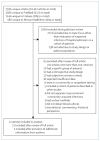Community-acquired bloodstream infections in Africa: a systematic review and meta-analysis
- PMID: 20510282
- PMCID: PMC3168734
- DOI: 10.1016/S1473-3099(10)70072-4
Community-acquired bloodstream infections in Africa: a systematic review and meta-analysis
Abstract
Data on the prevalence and causes of community-acquired bloodstream infections in Africa are scarce. We searched three databases for studies that prospectively studied patients admitted to hospital with at least a blood culture, and found 22 eligible studies describing 58 296 patients, of whom 2051 (13.5%) of 15 166 adults and 3527 (8.2%) of 43 130 children had bloodstream infections. 1643 (29.1%) non-malaria bloodstream infections were due to Salmonella enterica (58.4% of these non-typhoidal Salmonella), the most prevalent isolate overall and in adults, and 1031 (18.3% overall) were due to Streptococcus pneumoniae, the most common isolate in children. Other common isolates included Staphylococcus aureus (531 infections; 9.5%) and Escherichia coli (412; 7.3%). Mycobacterium tuberculosis complex accounted for 166 (30.7%) of 539 isolates in seven studies that used mycobacterial culture techniques. HIV infection was associated with any bloodstream infection, particularly with S enterica and M tuberculosis complex bacteraemia. Where recorded, patients with bloodstream infections had an in-hospital case fatality of 18.1%. Our results show that bloodstream infections are common and associated with high mortality. Improved clinical microbiology services and reassessment of empirical treatment guidelines that account for the epidemiology of bloodstream infections might contribute to better outcomes.
2010 Elsevier Ltd. All rights reserved.
Conflict of interest statement
Figures


References
-
- Petit PL, van Ginneken JK. Analysis of hospital records in four African countries, 1975–1990, with emphasis on infectious diseases. J Trop Med Hyg. 1995;98:217–27. - PubMed
-
- Bahwere P, Levy J, Hennart P, et al. Community-acquired bacteremia among hospitalized children in rural central Africa. Int J Infect Dis. 2001;5:180–88. - PubMed
-
- Campbell JD, Kotloff KL, Sow SO, et al. Invasive pneumococcal infections among hospitalized children in Bamako, Mali. Pediatr Infect Dis J. 2004;23:642–49. - PubMed
-
- Peters RP, Zijlstra EE, Schijffelen MJ, et al. A prospective study of bloodstream infections as cause of fever in Malawi: clinical predictors and implications for management. Trop Med Int Health. 2004;9:928–34. - PubMed
-
- Floyd K, Reid RA, Wilkinson D, Gilks CF. Admission trends in a rural South African hospital during the early years of the HIV epidemic. JAMA. 1999;282:1087–91. - PubMed
Publication types
MeSH terms
Grants and funding
LinkOut - more resources
Full Text Sources
Other Literature Sources

